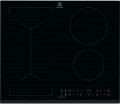Controls
The type of control used in the hob. The options might be:
—
Rotary knobs. Control based on classic rotary knobs. Sometimes buttons are also provided in the design but they are only responsible for the additional functions of the device. It is the knobs that control the switching on and power of the burners (and the combination of knobs and youch controls is indicated separately — see below). This type of control is known for its simplicity, convenience, reliability and low cost, which make it extremely popular — it is used in most modern hobs of an independent type (see above).
—
Touch controls. touch controls can control almost all functions of the hob, while the set of such functions can be very extensive. Among the advantages of touch sensors, one can note a stylish appearance, ease of cleaning due to the absence of protruding parts, and the touch controls do not need to be pressed — a light touch is enough. The main disadvantage of this type of control is its high cost, but it is mainly used in high-end hobs, where the price of touch controls is almost invisible compared to the cost of the entire device.
— Rotary knobs + touch controls. Combination of rotary knobs (see above) with touch controls. Note that only rotary knobs are enough for basic control of the burners, and buttons can also be used for additional functions — they are cheaper than touch controls. Therefore, t
...his type of control usually means that we have a rather expensive model with an abundance of additional functions. Among the advantages of touch controls, one can note a neat and stylish appearance, as well as ease of cleaning — they, unlike buttons, do not have slots and protruding parts where dirt can accumulate. And some models with similar controls have a rather unusual design — for example, only one rotary knob, the purpose of which is changed by commands from the touch controls.
— Touch + magnetic disk. Touch controls (see above), supplemented by a special rotary control — a magnetic disk. This disc is somewhat similar to rotary knobs, but it is called magnetic because of the fastening — with a permanent magnet, which allows you to remove the control. Most often, there is one disc for all burners; less often there are models with their disc for each burner. However, such a regulator has two key differences from rotary knobs. Firstly, the magnetic disk controls not only the power but most of the other functions of the hob. Secondly, the discs look neater and are more comfortable to use: they spin easily, and the detachable design makes them easy to clean and keeps children out of the way. However, it makes sense to use this control method mainly in high-end hobs with an abundance of functions.
— On the oven. As the name implies, such hobs do not have their control — it is carried out from the oven control panel to which the device is connected. This variant, by definition, only occurs in dependent models (see "Type").
— Slider. A kind of touch controls. Often they are elongated in a slender line; less often they are made in the shape of a circle. To adjust the heating intensity of the burners or quickly access other settings of the hob, slide your finger along the corresponding touch scale to the selected value. The convenience of slider control is that you can immediately set the required heating power by clicking on a certain area of the scale.
— Separate. Control using sensors or sliders (see the corresponding paragraphs), which implies the ability to fine-tune the operation of the burners individually - each of them has its own power adjustment scale. Separate control allows you to set the required heating level for a specific zone without having to first select a specific burner by tapping on the panel. It is more intuitive and gives you more flexibility when preparing different dishes overnight.Number of power levels
The number of temperature settings of the burner. The more power levels, the more accurately you can set the required temperature for cooking a particular dish. However, in most cases, nine levels are enough for home use. But, if you are a gourmet and often cook unusual dishes that require strict adherence to the recipe, then you simply need more temperature settings.
Country of origin
The country in which, according to the manufacturer, this or that model is manufactured. Despite the fact that most of the manufacturers are concentrated
in China, European factories for the production of household appliances have not disappeared. And certain models can be produced on them. In general, such a division into a Chinese or European plant should not particularly affect the quality of products, but still the stereotype of a reliable European assembly (
Germany,
Spain,
Italy,
Poland,
Turkey) is present in us. However, it is possible that the model may have a country of manufacture, for example, Poland, and in the store under the same article you will meet China.

